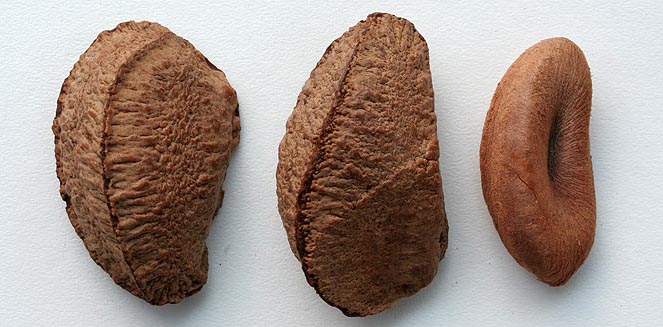Bertholletia excelsa (Brazil nut) Life
> eukaryotes >
Archaeoplastida >
Chloroplastida
>
Charophyta > Streptophytina > Plantae (land plants)
> Tracheophyta (vascular plants) > Euphyllophyta > Lignophyta (woody plants)
> Spermatophyta (seed plants) > Angiospermae (flowering
plants) > Eudicotyledons > Core Eudicots > Asterids > Order: Ericales > Family: Lecythidaceae
 |
|
Brazil nuts. [photo H. Robertson, Iziko
©] |
Brazil nut trees are native to the Amazon rain forest in South
America. Trees are about 45 m high and bear woody pods, each pod
containing 12 to 20 hard-shelled seeds that we know as Brazil nuts. Most
Brazil nuts are harvested from wild trees in Brazil and exported. The
kernel of a Brazil nut contains about 67% fat and eating one nut is
about the caloric equivalent of eating an egg! They are a good source of
phosphorus and thiamin and contain some calcium.
Brazil nut trees are native to the Amazon rain forest
in South America where they grow mainly along the Amazon, Orinaco and Rio Negro
rivers. Trees are typically about 45 m high and 1.8 m in diameter. They bear
woody pods, each pod containing 12 to 20 hard-shelled seeds that are triangular
in cross-section and arranged in the pod rather like wedges of an orange. It is
these seeds that we term Brazil nuts. Nuts are harvested from pods that have
fallen to the ground and harvesters have to protect themselves from falling pods
by using shields and/or hard-hats. Most Brazil nuts are harvested from wild
trees. There are only a few commercial plantations in Brazil and evidently none
elsewhere. So when you eat a Brazil nut, you know that it has been imported from
Brazil and probably came from a wild trees in the Amazon rain forest. Exporting
of Brazil nuts commenced in about 1835; there is relatively little consumption
of these nuts in Brazil itself.
The kernel of a Brazil nut contains about 67% fat
(macadamias have 72% and pecans 71%, whereas almonds have 54% and cashews 46%
fat), mainly unsaturated. Eating one nut is about the caloric equivalent of
eating an egg! They are a good source of phosphorus and thiamin and contain some
calcium.
Publications
-
Anon. 2002. Encyclopedia of Foods. A Guide
to Healthy Nutrition. Academic Press, San Diego, California.
-
McGee, H. 1991 (first published 1984). On
Food and Cooking. The Science and Lore of the Kitchen. Harper Collins,
London.
|
